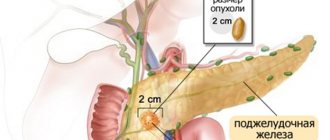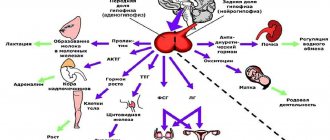Among all diseases of the gastrointestinal tract (GIT), the incidence of chronic pancreatitis ranges from 5.1 to 9%, and in the last few decades, the incidence of pancreatitis in our country has doubled1.
Chronic pancreatitis is an insidious disease, largely due to its recurrent nature. Patients are often concerned about periods of exacerbation, accompanied by severe pain, nausea, and vomiting.
Where does chronic pancreatitis come from? What causes the disease and is it possible to fight it? Let's try to figure it out.
Symptoms of chronic pancreatitis
Symptoms of chronic pancreatitis may vary depending on the stage (remission or exacerbation), course and physical condition of the patient. The main signs of the disease are as follows:
- acute pain without clear localization. Pain can be felt in the right hypochondrium, upper or middle abdomen and spread to the back. In many patients, pain occurs immediately after eating, especially if the diet contained fatty, smoked or spicy foods;
- frequent loose stools are one of the main signs of indigestion. Digestive problems in chronic pancreatitis are caused by a lack of enzymes;
- heaviness in the abdomen, nausea, which also indicate a lack of digestive enzymes;
- increasing feeling of hunger, muscle tremors, weakness, cold sweat;
- intoxication, manifested in fever, chronic fatigue, and a feeling of general malaise.
Major diseases of the pancreas
Most pathologies of the pancreas begin to develop with pancreatitis. It can have 2 forms - acute and chronic. In turn, acute pancreatitis is of 3 types:
- Edema – accompanied by severe swelling of the gland, which disappears within 5-10 days.
- Sterile pancreatic necrosis - some of the gland cells die, which is not associated with infection.
- Infected pancreatic necrosis - in this case, cells die due to infection. This is the most dangerous condition, leading to death in 80% of cases.
Chronic pancreatitis develops over a long period of time and is not accompanied by acute pain. This disease most often occurs in the age group of 35-50 years. The pain can be either constant or paroxysmal (around the abdomen). This symptom is the most characteristic.
Causes of chronic pancreatitis
One of the most common causes of chronic pancreatitis is poor diet and unhealthy lifestyle. Constant overeating, abuse of fatty foods and alcohol cause blockage of the excretory ducts of the pancreas.
Narrowed excretory ducts provoke the accumulation and premature activation of digestive enzymes. As a result, the pancreas actually begins to digest itself, and inflammation forms1.
In addition, the following factors can lead to chronic pancreatitis3:
- ulcer of the duodenum, stomach and enteritis. Chronic inflammation of the mucous membrane of the gastrointestinal tract makes it difficult to secrete pancreatic juice, which often causes chronic pancreatitis;
- cholelithiasis. After leaving the gallbladder, the stone causes blockage of the common duct and inflammation of the pancreas develops;
- genetic predisposition;
- toxic effects of drugs.
Diagnosis of chronic pancreatitis
Identifying chronic pancreatitis can be difficult due to the nonspecific clinical picture. Nausea, abdominal pain, digestive problems - these symptoms are characteristic of many diseases, for example, stomach ulcers or chronic cholecystitis. Therefore, identifying the disease may require a whole range of studies. Diagnosis of chronic pancreatitis may include2,3:
- external examination of the patient. Chronic pancreatitis may be indicated by bluish areas of the skin on the front and side walls of the abdomen. In some patients, bright red patches of skin on the chest and back become noticeable. Palpation may reveal pain in the left hypochondrium and the upper third of the abdomen;
- a general and detailed blood test, which shows the presence of an inflammatory process, based on an increase in the concentration of leukocytes;
- laboratory blood test to identify markers of nutritional status;
- fecal elastase test;
- ultrasonography. In some cases, ultrasound examination (ultrasound) can be performed through the walls of the stomach and duodenum, which significantly increases the accuracy of the examination. This method is called endoUS and combines the possibility of endoscopic and ultrasound diagnostics of the gastrointestinal tract (GIT);
- computed tomography: used to determine complications of pancreatitis associated with thickening of the pancreas tissue.
Diagnosis of the disease at the private medical clinic “Medunion”
Diagnosing this disease is not difficult, since the first signs speak for themselves. However, in order to prescribe adequate treatment, it is necessary to determine the form of the disease. To do this, the doctor performs laparoscopy - a method that allows you to examine the abdominal cavity from the inside using a special instrument.
If acute pancreatitis is suspected, laboratory tests are performed:
- General blood analysis
- Blood chemistry
- Analysis of urine
- Stool analysis
- Ultrasound, MRI or radiography of the abdominal organs
- Computed tomography according to indications
In the chronic form, the same studies are carried out, but it is better to take tests during the period of exacerbation of the disease.
Exacerbation of chronic pancreatitis
Chronic pancreatitis may hardly manifest itself until the period of exacerbation. Relapse of the disease is usually associated with two main reasons3:
- alcohol consumption. Even a small amount of alcohol consumed can provoke the transition of the disease into the acute phase;
- violation of the diet, overeating, a large number of fatty, fried, spicy dishes on the menu.
Other factors can also provoke exacerbation of chronic pancreatitis in adults, for example, chronic stress, physical fatigue, poisoning or the toxic effects of certain medications3.
Exacerbation of the disease is manifested by the following symptoms3:
- attack of acute or dull pain in the hypochondrium. Painful sensations spread to the subscapular region or the entire back;
- progressive diarrhea. In this case, the feces have a characteristic greasy shine. Undigested food remains are often observed in the stool;
- the occurrence of specific bitterness in the oral cavity, nausea and loss of appetite;
- whitish coating on the surface of the tongue;
- weight loss.
Exacerbation of chronic pancreatitis in adults can last for one to two weeks. You cannot fight the disease on your own during this period: the best solution is hospitalization and constant monitoring by specialists.
Treatment of chronic pancreatitis
The answer to the question “how to cure chronic pancreatitis” remains open even for modern doctors. The treatment regimen is determined by the doctor for each individual case. The main thing is that therapy should be comprehensive, affecting the main cause of the disease.
Treatment of chronic pancreatitis includes2,3,4:
- immediate cessation of bad habits. Smoking and abuse of strong alcoholic beverages aggravate the inflammatory process and contribute to the subsequent development of the disease;
- strict adherence to the diet. The daily diet should contain high-calorie foods, without spicy foods, salt and pure sugar. You should eat food often, in small portions. In case of exacerbation of chronic pancreatitis, therapeutic fasting is prescribed, which will help stop pancreatic secretion and relieve pain. After 1-3 “hungry” days, the patient is transferred to a special diet;
- basic therapy. In this case, we are talking about taking the following type of drugs: antispasmodics and analgesics, antisecretory and detoxification drugs. Treatment is carried out under the supervision of a doctor with strict adherence to the instructions;
- taking enzyme preparations, the task of which is to compensate for the impaired functioning of the pancreas. The fact is that the pancreas does not recover (it is not the liver), and therefore will no longer be able to work at full capacity during chronic pancreatitis. That is why the first line of therapy is enzyme preparations, which should be taken for life. An example of an enzyme drug prescribed for chronic pancreatitis is Creon®;
- complex therapy. May include taking antispasmodics or analgesics, antisecretory and detoxification medications. Therapy is carried out under the supervision of a physician with strict adherence to the instructions;
- taking anti-inflammatory and painkillers that improve the patient’s well-being;
- herbal medicine, which can be prescribed during remission only as prescribed by a doctor.
What to do if an exacerbation of pancreatitis occurs suddenly, and the ambulance has not yet arrived? Before the doctors arrive, you need to lie down, try to relax your abdominal muscles as much as possible and apply a heating pad with cold water to the sore spot. You should not take painkillers or any other medications - this will interfere with correct diagnosis. And, of course, any food and drinks, even plain water, are strictly prohibited, because any food or liquid can cause increased pain3.
Intrascopic surgical technologies
Ultrasound examination reveals accumulations of enzymatic effusion in the abdominal cavity, omental bursa, retroperitoneal space and the zones of penetration of retroperitoneal tissue characteristic of each form of lesion. Drains with a diameter of 3 mm are installed in these areas according to the principle of “at least two in one drainage object.”
After fistulography, which assesses the nature of the spread of the process in the necrosis phase, the drains are replaced under x-ray control with double-lumen ones of larger diameter. This procedure must be repeated daily, every other day or two, depending on the specific clinical situation and the patient’s condition. Ultimately, depending on the size of the cavities being drained, drainages can reach a diameter of 5 – 20 mm. Subsequently, using a video endoscope, transfistula sanitation of retroperitoneal necrotic cavities and sequestral “fields” is performed, with correction and replacement of drainages. In this case, necrotic tissue and formed sequestration are removed.
The greater the number of “small-caliber” (thin – 1.5 – 3.3 mm in diameter) drainages are initially installed in each area of exudate and necrosis, the easier it is to perform sanitizing procedures in the future, because The location of the tube does not always allow you to change its direction or replace it with a “large-caliber” one (wider - 5 - 20 mm). In addition, in the event of a fistula of a hollow organ due to a bedsore, one of the drains can be removed without compromising the drainage of this cavity.
The use of a video fiber endoscope allows you to visualize the affected retroperitoneal space, the pancreas and objectively assess the adequacy of the removal of necrotic tissue with the possible placement of the next double-lumen “large-caliber” drainage into a hard-to-reach “pocket”, even at an acute angle to the trajectory of the first “small-caliber” drainage.
As the cavities are cleaned and their size decreases, the reverse process occurs, replacing the drains with a smaller diameter and gradually removing them until the fistula tracts are closed. Simultaneously with the introduction of new technological techniques, a restructuring of medical and nursing care is required, a change in some key principles of the formation of medical personnel and instrumental support: The principle of highly qualified medical versatility. New treatment technologies require a doctor to perform almost daily minimally invasive surgical interventions (major surgical interventions) to sanitize foci of necrosis and suppuration under combined sonographic, endoscopic and x-ray control in a cath lab under general anesthesia. Thus, a doctor who treats destructive pancreatitis using modern methods must be fluent in several specialties - surgery, intensive care, ultrasound diagnostics, X-ray diagnostics, endoscopy. A different approach - several specialists, each of whom has only his own specialty, does not allow for treatment at the required modern level, maintaining the continuity of stages of treatment and the integrity of understanding the problems of a patient with pathology of the retroperitoneal space hidden from reliable visualization. The use of one universal specialist to solve the assigned problems meets the requirements of an intensive technological approach to complex minimally invasive surgical treatment of pancreatic necrosis. The principle of manipulation hierarchy. Minimally invasive technology for the treatment of destructive pancreatitis requires hourly sanitary surgical procedures in the intensive care unit (auxiliary surgical interventions). This surgical procedure is based on the sanitation of drainage systems installed in the patient in areas of necrosis and purulent process. In the intervals between medical surgical interventions, the affected areas are washed, sanitized, and drainage systems are corrected by the medical staff of the ward. For these purposes, a highly specialized physician assistant is required. His role can be played by: a nurse with a special surgical education (currently, a system of obtaining higher medical nursing education for nursing staff on the basis of medical universities is being formed); medical assistant (surgical nurse with higher education; medical student of 3-6 years); junior doctor (intern, clinical resident, graduate student, doctor on internship, doctor with up to 3 years of experience). A feature of surgical care is the control and implementation of active fractional and constant drainage-washing and corrective procedures within 24 hours with a minimum break of 30-60 minutes. The principle of instrumental accumulation. Since minimally invasive treatment methods for pancreatic necrosis require a combination of several intrascopic methods, the equipment of the operating room and the entire treatment process must meet modern standards. The main instrumental equipment of the operating room for manipulations under intrascopic control includes a surgical ultrasound scanner, an X-ray television installation and an endoscopic stand with a system of rigid and flexible endoscopes. The complex of visualization tools required by the technology for treating pancreatic necrosis necessarily includes computed tomography or magnetic resonance imaging, as an indispensable stage in the diagnosis of certain areas of necrotic and purulent lesions that are not accessible to sonographic techniques. A necessary condition for the implementation of the above principles is a change in the doctor’s psychology to acquire the skills of minimally invasive surgical interventions on the pancreas and retroperitoneal tissue for pancreatic necrosis under combined intrascopic control. The objective result of the work of the new functional unit in the Federal State Institution “RCFHG Roszdrav” was a steady decrease in mortality. During the period of prevalence of open methods of surgical treatment of pancreatic necrosis, with an insignificant proportion of minimally invasive technologies, the mortality rate in this group of patients was more than 50%. At the same time, a third of patients died in the first 10 days after hospitalization from progressive circulatory-toxic shock, 28% of patients died within more than 60 days from arrosive bleeding. The remaining causes of mortality were mainly sepsis and multiple organ failure syndrome.
At the stage of gradual abandonment of open operations, mortality experienced a fairly steady downward trend and, despite the “neglect” of patients entering the pancreatology center, ranged from 4% to 8% in the period 2003 - 2005.
Open surgical interventions on the abdominal cavity and organs of the retroperitoneal space remained in service with the surgeons of the Center only as a means of combating massive arrosive bleeding that is not amenable to conservative and angio-roentgensurgical methods of hemostasis, or to perform colo- and ileostomy in case of acute intestinal obstruction.
Treatment of pancreatic necrosis in the traditional way
Treatment of pancreatic necrosis using minimally invasive technologies
The drug Creon® 25000 for chronic pancreatitis
Find out more
Decreased pancreatic function inevitably leads to a lack of digestive enzymes in the body, so-called enzyme deficiency. As a result, the quality of digestion suffers, and the body does not receive the necessary energy and nutrients for full functioning. Creon® is designed specifically to compensate for the lack of its own enzymes through their delivery from the outside and belongs to the group of enzyme preparations. The drug contains enzymes identical to those produced by the pancreas. The key feature is that the active ingredient Creon® is small particles - minimicrospheres, which are collected in a capsule. The fact is that science has been studying enzyme preparations for more than 100 years in order to increase their effectiveness. To date, scientific advances indicate that preparations with particles whose size does not exceed 2 mm4.5 can most accurately recreate the natural process of digestion. Moreover, it has been scientifically proven that the smaller the particles of the drug, the more effective it can be4,6.
Creon® is the only drug whose capsule contains hundreds of small particles - minimicrospheres7. Their size does not exceed 2 mm, which is recorded as recommended in world and Russian scientific works4,5,6.
Diabetes
Pancreas as a vital organ
Diabetes mellitus is another of the most common diseases of the pancreas, which is associated with the lack of insulin production. In most cases, diabetes develops gradually, thereby sometimes smoothing out all the symptoms and allowing the person to get used to them. And this is very dangerous. The main signs that a person has diabetes include:
- Feeling of dry mouth. Moreover, the feeling will be constant, and even if you drink a large amount of water, it will not go away
- Increased urine output
- A sharp increase, and in some cases a sharp decrease in a person’s weight
- Dry skin
- Formation of pustules on the skin
- Constant feeling of muscle weakness
- Severe, even small wounds take a very long time to heal
If the disease has progressed to a more severe stage, then the person’s vision may deteriorate, wounds begin to appear that take a very long time to heal, constant headaches are tormented, consciousness is impaired, and a persistent smell of acetone is felt from the person’s skin. The main causes of diabetes include:
- Heredity. Those at risk are those whose parents or grandparents had this disease
- Excess weight
- Stress
- Age. Scientists have proven that the older a person is, the more likely he is to develop diabetes.
Due to the fact that the body stops producing insulin, it needs to be replenished. Quite often, patients are prescribed insulin injections. If the stage of diabetes is mild, then you can get by by taking pills or following a strict diet.
What else is important to know about enzyme preparations?
The minimum starting dosage is Creon® 25,000 units, which is stated in Russian recommendations for the treatment of chronic pancreatitis and exocrine pancreatic insufficiency2,5. The number indicates the amount of the enzyme lipase, which helps digest fats. If necessary, the doctor can increase the dosage; in European practice, the required dose per single dose can reach up to 80,000 units8. By comparison, the pancreas of a healthy person produces up to 720,000 of these units during each meal9.
Therapy should be taken seriously, since high-quality “nutrition” of the body is the key to its functioning. How long can a person live without energy from food? With chronic pancreatitis, the body must be supplied with enzymes at every meal, even with a snack. Thus, in accordance with the instructions for the drug Creon®, a full dose is required for a meal (for example, 25,000 units), and half for a snack. Creon® capsules are convenient to use: you can open them and add minimicrospheres to food, thereby selecting the desired dose10. More information about the admission rules can be found here.









